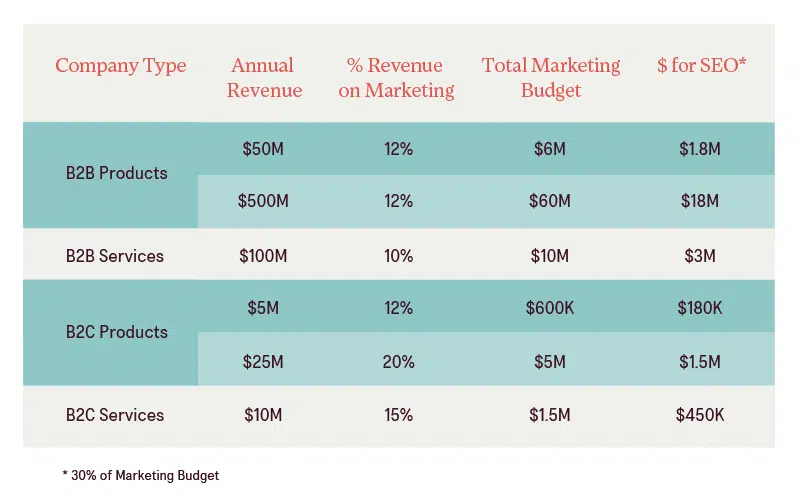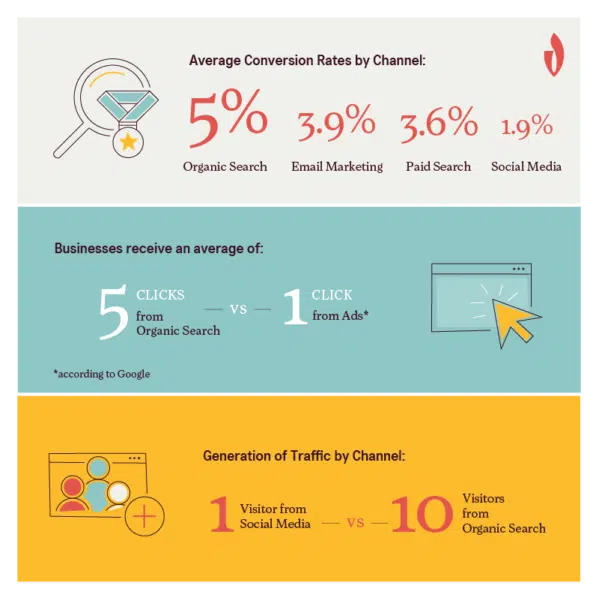
A steady upward trend in SEO spending indicates that marketers realize the role SEO plays in helping prospective customers find their offerings. In 2020 alone, US businesses invested an estimated $79.3 billion to increase their organic footprint.
But even if you know how critical SEO is to your marketing, deciding how much to spend on it is another question. While there’s no single formula to set an SEO budget, here are some strategies you can leverage to find a number that’s right for your business.
Breaking down your marketing budget
Recent data suggests that B2C organizations spend an average of 5% to 12% of their revenue on marketing, and B2B puts aside about 8% to 9% of their revenue for marketing spend. Out of that total spend, as reported by Forrester Research, companies devote an average of half of their marketing budget to online strategies, such as SEO, direct email, social media, and data analytics. If you have an entirely web-based business, you’ll likely spend a greater percentage of your total budget on digital strategies.
Sample SEO budget breakdown
According to the 2021 CMO Survey, nearly 74% of companies invest in SEO. Every business has distinct needs, and the amount you should budget depends on your business model and niche, but it can still be helpful to look at some examples.
The following chart shows average budget breakdowns for different types of companies (B2B or B2C) with different levels of revenue, based on the same survey data.


This table suggests what your overall marketing and SEO budget might look like at a high level.
Now let’s go a level deeper. How are you strategizing that valuable budget to ensure it helps you deliver on your annual marketing numbers?
5 methods to determine how much to spend on SEO
You have options when you’re budgeting for SEO, with methods ranging from rough percentages of total revenue to more precise calculations based on marketing metrics:
1. Commit a proportion of your overall marketing budget
How it works
Set aside a percentage of your digital marketing budget based on how much you rely on website traffic to generate sales. (An e-commerce business, for example, would likely choose to spend more on SEO than their brick-and-mortar counterpart.)
You can do the same with a flat dollar amount: examine the line items in your marketing budget and decide what you think you can afford to set aside for SEO.
Keep in mind
Allocating a bulk percentage of your marketing budget doesn’t account for your specific SEO needs.
Basing your SEO budget on what you think you can afford might mean you’re not spending enough to see meaningful results. In a large-scale analysis of SEO services, Backlinko found a direct correlation between spending and satisfaction. The data reveals that those who opted for low-budget SEO walked away less satisfied than those who invested more fully in SEO as a marketing channel.
2. Match your competition
How it works
Businesses with competitors that aggressively target industry keywords have to commit more to SEO to maintain a share of organic traffic. Compare your existing search engine rankings to your competition, and measure the opportunity cost of losing customers to them.
Keep in mind
This approach helps you decide how much to prioritize SEO, but it may only take you halfway there. The next step is to determine the SEO budget you’ll need to outrank your competitors, and you can get a free SEO consultation to answer that question.
3. Consider your marketing objectives
How it works
Think about your SEO goals in the context of your broader marketing objectives before allocating a specific dollar amount to that line in your budget.
Where does SEO fit in? Think about your organic search potential with a realistic mindset. Are you relying on organic traffic growth to meet key KPIs like leads or sales? Or are you meeting your revenue goals and looking to expand brand awareness? Make sure you set the right internal expectations for your marketing investment and enough in the channel to achieve the desired results.
Keep in mind
It takes rigorous planning to align your budget with your objectives, but this ensures that your funds are distributed in a way that supports your goals.
4. Calculate budget using Customer Lifetime Value (CLTV)
How it works
The benefits of organic traffic extend beyond a one-time purchase, especially if you focus on customer satisfaction, retention, and brand loyalty. This approach determines the value of a web page based on Customer Lifetime Value (CLTV) — the amount you can expect to earn from a customer long-term.
Let’s say your business has a transactional page on your website that gets 10,000 visitors a month. If you convert 1% of visitors, you’re selling to 100 customers a month. Now, if your CLTV is $3,000, your web page is worth $300,000 over time.
You can use this figure to work out an amount to spend on SEO. Perhaps you want your SEO strategies to lift traffic by 10%, generating another 1,000 visitors a month. With a 1% conversion rate, that traffic will directly bring in 10 new customers, giving you $30,000 of value to map back to that SEO investment.
Keep in mind
Which comes first, SEO or CRO? If you’re budgeting for SEO, then the answer is SEO. But if you’re using CLTV to determine page value, make sure to keep in mind the different factors that impact conversion. If conversion rates figure into the profitability of your SEO efforts, you can amplify your SEO spend by investing in CRO and UX improvements to increase your site’s conversion rates. These two marketing strategies work together to improve bottom-line impacts.
5. Determine the effectiveness of SEO vs. paid search spend
How it works
You can also budget SEO in relation to your PPC ad spend, considering the effectiveness of each marketing strategy.
Most companies feel comfortable budgeting for PPC and spend more on PPC than SEO, according to Marketing Sherpa. However, SEO typically generates twice as much traffic. Research shows organic search generates an average of 53% of website traffic, while paid search generates about 15% of traffic.
What about e-commerce conversions? Or closed won deals? Look at your own data to compare the ROI across paid traffic and organic traffic, and make sure your comparative budgets are in line with your returns.
If SEO brings more high-quality visitors to your site, consider re-apportioning your digital marketing budget to reflect SEO’s bigger returns on your investment. Review this comprehensive comparison of SEO vs. PPC.
Keep in mind
While PPC can generate fast results, once you stop running ads, your visibility drops. On the other hand, an optimized website that’s ranking well can gain momentum and continue to drive traffic over the long term. Consider a mix of SEO and PPC that’s aligned with your evolving business needs.
The case for increasing your SEO budget
As you start crunching numbers to figure out how much to spend on SEO, you may arrive at higher figures than you expected.
Your budget stakeholders might not understand the benefits of investing in SEO, so here are a few helpful points to communicate up.
Bargain-basement SEO won’t deliver significant results
There’s a link between SEO spending and satisfaction. Backlinko found that customers who invested above a minimal threshold were 53.3% more likely to be “extremely satisfied” as compared to those spending less.
SEO is highly effective compared to other channels
SEO is a relatively new digital marketing channel. Just because you (or your stakeholders) aren’t used to prioritizing it in the budget doesn’t mean that you shouldn’t start doing just that.
SEO boasts numerous stats that you can communicate to your stakeholders that support prioritizing SEO to create the highest ROI. For example, consider the following benchmarks.


Let the numbers do the talking, and plan your budget with your final ROI in mind.
Privacy changes are impacting online advertising
In the evolving online landscape, SEO remains a strong digital strategy.
Google and Apple are introducing restrictions on third-party cookies for privacy reasons, a move that’s expected to reduce the effectiveness of digital ad strategies. But these changes don’t impact first-party cookies you use to track customers on your own site.
SEO budgeting that makes sense for your business
Everybody’s budgeting process looks different, and you can adapt each of these methods to align your SEO budget with your annual goals. But perhaps the easiest way to plan for your SEO budget is to simply talk to an SEO consultant. It’s common for SEO marketing agencies to start with a free SEO consultation for this exact reason.
It’s designed to hone in on the most impactful SEO opportunities to focus your budget on and identify the level of investment needed to see impactful results. Most importantly, it’s an effective way to make sure you’re investing at the appropriate level before you commit your budget dollars.



